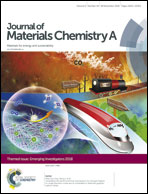Nanocatalysts for hydrogen production from borohydride hydrolysis: graphene-derived thin films with Ag- and Ni-based nanoparticles†
Abstract
Generation of hydrogen is one of the greatest challenges nowadays, especially chemically obtaining from the simple, straightforward borohydride hydrolysis reaction. Herein we are interested in this reaction for producing hydrogen using various nanocatalysts which are derived from graphene (reduced graphene oxide, rGO) and combined with metal-based nanoparticles (Ag, Ni and Ni(OH)2). Overall, four promising catalysts were obtained using the liquid–liquid interfacial route in order to obtain highly homogeneous thin films. We highlight the novelty in employing thin films for the generation of hydrogen gas, in which the reaction kinetics was thoroughly elucidated, obeying first-order profiles. In fact, very high catalytic activity was observed using low amounts of nanocatalysts (∼0.1–0.8 mg), with the maximum rate of hydrogen production reaching nearly 33 × 103 mL−1 min−1 g−1. rGO/Ni nanocomposites are reported here for the first time, which also showed the most prominent activity. The isolated components alone were not efficient, evidencing the synergism in the nanocomposites produced. Finally, the nanocatalysts were recycled for up to 10 consecutive cycles, without losing activity. Various characterization techniques were performed during the reactions and after the reuse and confirmed that the typical nature of the composites remains intact.

- This article is part of the themed collections: Materials and Nano Research in Brazil and Journal of Materials Chemistry A Emerging Investigators


 Please wait while we load your content...
Please wait while we load your content...